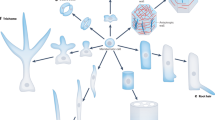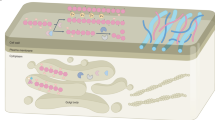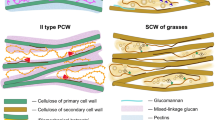Abstract
The study of plant cell wall formation has led to investigations of polysaccharide biosynthesis in cell-free systems1–8. Those systems which have been studied have certain common properties: they are all particulate enzymes; they are all relatively unstable; and those for which the specificity of the substrate has been determined are known to utilize a single sugar nucleotide2,5,7. Detailed characteristics have been reported in some cases5,8, but there is little information which serves to organize these data into a working hypothesis concerning the mechanism of cell wall formation. This report supports the hypothesis9 that the various polysaccharide-synthesizing enzymes originate from a single type of organelle. Furthermore, sedimentation properties suggest that this organelle is the plasma membrane.
This is a preview of subscription content, access via your institution
Access options
Subscribe to this journal
Receive 51 print issues and online access
$199.00 per year
only $3.90 per issue
Buy this article
- Purchase on Springer Link
- Instant access to full article PDF
Prices may be subject to local taxes which are calculated during checkout
Similar content being viewed by others
References
Feingold, D. S., Neufeld, E. F., and Hassid, W. Z., J. Biol. Chem., 233, 783 (1958).
Barber, G. A., Elbein, A. D., and Hassid, W. Z., J. Biol. Chem., 239, 4056 (1964).
Brummond, D. A., and Gibbons, A. P., Biochem. Z., 342, 308 (1965).
Villemez, C. L., Lin, T. Y., and Hassid, W. Z., Proc. US Nat. Acad. Sci., 54, 1626 (1965).
Villemez, C. L., Swanson, A. L., and Hassid, W. Z., Arch. Biochem. Biophys., 116, 446 (1966).
Bailey, R. W., and Hassid, W. Z., Proc. US Nat. Acad. Sci., 56, 1586 (1966).
Villemez, C. L., Franz, G., and Hassid, W. Z., Plant Physiol., 42, 1219 (1967).
McNab, J. M., Villemez, C. L., and Albersheim, P., Biochem. J., 106, 355 (1968).
Villemez, C. L., McNab, J. M., Grimes, W. J., and Albersheim, P., Fed. Proc., 26, 805 (1967).
Jensen, R. G., and Bassham, J. A., Proc. US Nat. Acad. Sci., 56, 1095 (1966).
Morre, D. J., Mollenhauer, H. H., and Chambers, J. E., Exp. Cell Res., 38, 672 (1965).
Aspinall, G. O., and Kessler, G., Chem. and Indust., Lond., 1296 (1957).
Kessler, G., Ber. Schweiz. Bot. Ges., 68, 5 (1958).
Pickett-Heaps, J. D., Protoplasma, 64, 49 (1967).
Whaley, W. G., and Mollenhauer, H. H., J. Cell Biol., 17, 216 (1963).
Author information
Authors and Affiliations
Rights and permissions
About this article
Cite this article
VILLEMEZ, C., MCNAB, J. & ALBERSHEIM, P. Formation of Plant Cell Wall Polysaccharides. Nature 218, 878–880 (1968). https://doi.org/10.1038/218878a0
Received:
Revised:
Published:
Issue Date:
DOI: https://doi.org/10.1038/218878a0
This article is cited by
-
Spore Adhesion and Cell Wall Formation in Gelidium Floridanum (Rhodophyta, Gelidiales)
Journal of Applied Phycology (2006)
-
A study of cell wall regeneration of protoplasts inMarchantia polymorpha L.
The Botanical Magazine Tokyo (1983)
-
The organization of cortical microtubule arrays in the radish root hair
Protoplasma (1980)
-
Ultrastructure of the cell wall regeneration of isolated protoplasts of Skimmia japonica thunb
Planta (1977)
-
Cellulose microfibril deposition at the plasmalemma surface of regenerating tobacco mesophyll protoplasts: A deep-etch study
Planta (1975)
Comments
By submitting a comment you agree to abide by our Terms and Community Guidelines. If you find something abusive or that does not comply with our terms or guidelines please flag it as inappropriate.



